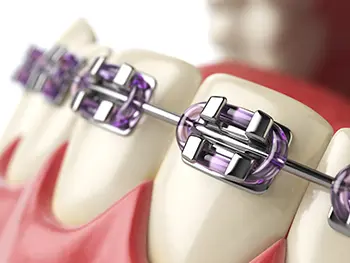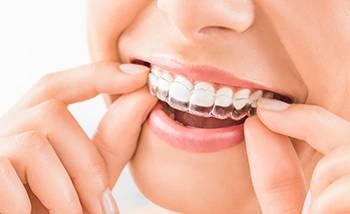Malocclusion, often referred to as “bad bite” is among the top common dental issues in America. Malocclusion occurs when your upper and lower teeth do not align when your mouth is closed and typically happens when teeth are crowded or crooked. There are several levels of malocclusion, ranging from mild to severe.
Typically, malocclusion is treated with traditional braces or clear aligners such as Invisalign. Some of the more serious cases of malocclusion may require surgery.
At Abadin Dental, we offer braces or Invisalign based on your personal preferences or your dental condition. Dr. Abadin is the only general dentist in the state of Florida that has achieved the title of Diamond Provider from Invisalign.
Braces vs. Invisalign Comparison Chart
| Braces | Invisalign | |
| Time to achieve desired results | 1 to 3 years, with most patients achieving full results in 2 years | 12 to 18 months, with most patients achieving results in 12 months, sometimes as little as 6 |
| Cost | Metal: $5,000 to $6,000 Ceramic: $4,000 to $8,500 Lingual: $5,000 to $13,000 | $3,500 to $8,000, depending on length of treatment and number of aligners required |
| Maintenance | Must visit the dentist every 2 weeks or so for adjustments | Does not require maintenance visits to the dentist |
| Cleaning | Must take extra care when brushing teeth to get around the wires and brackets | Can be removed so dental hygiene is easy, aligners must be rinsed before being put back in and must be washed once daily with special cleaner |
| Dental Check-ups | Must visit the dentist approximately every 2 weeks for adjustments and monitoring of progress | Must visit the dentist approximately every 4 to 6 weeks to monitor progress, do not need to come in to switch aligners |
| Advantages |
|
|
| Disadvantages |
|
|
| Ideal for | All patients, mild to severe malocclusion | Teen and adult patients, mild to moderate malocclusion |
| Effectiveness | Effectively treats all levels of malocclusion, may take longer for some than others | When worn as directed (20 to 22 hours a day), effective for resolving mild to moderate cases of malocclusion |
Time to achieve desired results
Braces
1 to 3 years, with most patients achieving full results in 2 years
Invisalign
12 to 18 months, with most patients achieving results in 12 months, sometimes as little as 6
Cost
Braces
Metal: $5,000 to $6,000 Ceramic: $4,000 to $8,500 Lingual: $5,000 to $13,000
Invisalign
$3,500 to $8,000, depending on length of treatment and number of aligners required
Maintenance
Braces
Must visit the dentist every 2 weeks or so for adjustments
Invisalign
Does not require maintenance visits to the dentist
Cleaning
Braces
Must take extra care when brushing teeth to get around the wires and brackets
Invisalign
Can be removed so dental hygiene is easy, aligners must be rinsed before being put back in and must be washed once daily with special cleaner
Dental Check-ups
Braces
Must visit the dentist approximately every 2 weeks for adjustments and monitoring of progress
Invisalign
Must visit the dentist approximately every 4 to 6 weeks to monitor progress, do not need to come in to switch aligners
Advantages
Braces
- Suitable for all ages
- May work faster
- Treats complicated orthodontic issues
- More affordable
- More durable
Invisalign
- Comfortable
- Discreet
- Fast results
- Less visits to the dental clinic
- Not as many restrictions
Disadvantages
Braces
- High maintenance
- Discomfort
- Limitations
- Unpleasant aesthetics
- May take longer, depending on severity of malocclusion
Invisalign
- Requires expert professional or orthodontist
- Careful handling
Ideal for
Braces
All patients, mild to severe malocclusion
Invisalign
Teen and adult patients, mild to moderate malocclusion
Effectiveness
Braces
Effectively treats all levels of malocclusion, may take longer for some than others
Invisalign
When worn as directed (20 to 22 hours a day), effective for resolving mild to moderate cases of malocclusion
Braces

Types of Braces
Metal
Metal braces, also known as traditional or conventional braces, are often referred to as “train tracks” because they look like tracks running across your teeth. This is the oldest and most familiar type of braces. While there have been many advancements in the field of orthodontics through the years, this is still one of the more common options since they are the least expensive for safe, effective teeth straightening.
They are known for the metal brackets and wires that, with the help of rubber bands, treat even the most severe malocclusion. Plus, if you want, you can jazz them up by using colorful bands.
Ceramic
Ceramic, or clear, braces are similar to metal braces. The biggest difference is that they are clear or tooth-colored instead of silver. The brackets are made of ceramic and the wires are metal. Most teen and adult orthodontic patients prefer ceramic braces over traditional metal braces because they are less conspicuous.
Lingual/Incognito Braces
Another option for fixed braces is lingual, or incognito, braces. These are attached behind the teeth instead of on the front. Therefore, unless your mouth is open, no one will know that you have braces. They work like metal braces with the exception of the way they are positioned.
Lingual braces are ideal for patients who are self-conscious about their smiles. They want to straighten their teeth, but they don’t want it to be obvious that they have braces. This treatment takes longer but has many advantages over the more obvious treatment options.
Advantages of Braces
Traditional metal, ceramic, or lingual braces have several advantages:
Suitable for all ages
Clear aligners are designed for adults and teens. Sometimes, children need orthodontic treatment for malocclusion. In this case, traditional braces are the more appropriate option.
May work faster
There is some debate on which type of braces works faster. For some malocclusions, traditional braces will work faster. Dr. Abadin will evaluate the severity and type of malocclusion you have to determine which would be the best treatment option and how long it would take.
Treats complicated orthodontic issues
For patients who have complex orthodontic issues, such as severe overbite, underbite, overcrowding, or significant gaps between teeth, traditional braces may be a better option than clear aligners. Traditional braces are also more effective at correcting significant jaw alignment issues.
More affordable
Orthodontic treatments are expensive- especially if you have more than one child that needs treatment. Metal braces are typically more affordable than clear aligners, which can be a major deciding factor for some families.
More durable
Traditional braces are fixed in place, which means they are less likely to get broken than clear aligners. Plus, metal is generally more durable than plastic.
Disadvantages of Braces
On the other hand, traditional braces also have several disadvantages.
High Maintenance
Orthodontic patients with traditional braces must visit the office every few weeks for adjustments as well as to check the progress of treatment. Plus, though metal braces are more durable than clear aligners, the wires and brackets are prone to breaking, especially if you don’t follow the rules for properly caring for them.
Discomfort
When you first get traditional braces, they are a bit uncomfortable. They put pressure on your teeth so that they can be shifted into the appropriate position- but you should get used to this after a few weeks. However, the brackets and wires may cut your cheeks and tongue- especially when they break.
Limitations
There are many foods and beverages that are off-limits for patients with traditional braces- especially when it comes to foods that increase your risk of developing cavities or damaging the hardware. This includes sodas and sweets- especially gummy or sticky candies that can get stuck in the wires and brackets. You also have to avoid hard snacks like jawbreakers, popcorn, and more because they can damage the wires and brackets as well.
Unpleasant aesthetics
Traditional metal braces are obvious and can be seen from a short distance. Even ceramic and lingual braces can be seen when talking to someone, though they are designed to be less obvious.
May take longer
For patients with more severe malocclusions, traditional braces may take longer. Some patients must wear them for up to 2 years to see full results.
Invisalign

Since Invisalign was invented, there have been numerous other clear aligner brands that have hit the market- but Invisalign remains the most popular and effective.
If you are interested in finding out if Invisalign is the right option for your malocclusion, schedule your consultation with Dr. Abadin today at Abadin Dental in Coral Gables, Florida. He will be able to evaluate your condition and determine the best solution to straighten your teeth.
If you decide to move forward with Invisalign clear aligners, you’ll start with x-rays and an impression of your mouth. These will be sent to the lab so that your aligners can be customized to fit you. Once the aligners are made, they will be sent to the office, and you will come in to have your first set of trays put in. After that, we will send you home with the rest and you’ll be instructed to switch to a new set approximately every 2 to 3 weeks.
For our teen patients, we offer Invisalign Teen, which is basically the same as the standard Invisalign, with one exception: a series of blue dots. The blue dots fade away over time if the aligners are being worn as instructed. While this isn’t completely fail-safe, it does help parents keep a closer eye on their teen’s progress. If the blue dots are not fading, the aligners are probably not being worn as instructed.
Advantages of Invisalign
There are several advantages of treating your malocclusion with Invisalign.
Invisalign is more comfortable
Invisalign clear aligners are made of smooth, transparent plastic. Therefore, you don’t have to worry about brackets and wires cutting your cheeks and tongue. They do put some pressure on your teeth when you first put them in or change to a new set of aligners, but that discomfort doesn’t last long. You get adjusted to the aligners fairly quickly.
Invisalign is more natural looking
Since the aligners are transparent, they are not as visible. Most people won’t even realize that you have them in, even when they’re standing right in front of you- unless you tell them.
Invisalign is quick
Most patients see full results within 12 to 18 months- and some even achieve full results in 6 months. Typically, you’ll begin seeing results with your very first set of aligners. However, for best results, the aligners must be worn 20 to 22 hours a day- even while sleeping.
Invisalign doesn’t require as many dental visits
After your first set of aligners is put in and fitted properly, you’ll be sent home with the rest of your aligners. You will switch to a new set every 2 to 3 weeks on your own. We will schedule follow-up appointments every 4 to 6 weeks so that we can track your progress and ensure that treatment is going as expected.
Invisalign doesn’t have as many restrictions
Since Invisalign clear aligners can be removed for eating and drinking, you don’t have to worry about restrictions. You can still eat and drink your favorite foods and beverages because you can clean your teeth properly afterward. However, you must make sure that you brush and floss your teeth, as well as clean the aligners, and put them back in once you are finished.
Disadvantages of Invisalign
It’s also important to note that as wonderful as Invisalign is, there are a few disadvantages as well:
Invisalign does require the services of a professional
As a general rule, Invisalign requires the services of an expert professional or orthodontist. Most general dentists do not offer Invisalign in their office- you will be referred to a specialist. Dr. Abadin is the only general dentist in the state of Florida that has achieved the title of Diamond Provider from Invisalign.
Invisalign clear aligners are delicate
Invisalign clear aligners can be removed for eating or drinking and practicing proper dental hygiene habits. Therefore, you must take care that you do not break or lose them, which is one of the reasons this option is only recommended for teens and adults. Children are much more likely to lose or break them or forget to put them back in.
Conclusion
At Abadin Dental, we treat a variety of dental conditions, including malocclusion. We offer several options for correcting all variations of malocclusion from very mild to severe. If you have a very severe malocclusion that involves a jaw misalignment, you may require surgery. However, most of the time, we can treat this condition with either braces or Invisalign clear aligners.
Both braces and Invisalign have their advantages and disadvantages. However, especially for our teen and adult patients, Invisalign seems to have the most advantages. For our pediatric patients, traditional braces are still the way to go.
If you have malocclusion and believe that you may benefit from either traditional braces or Invisalign, schedule your consultation with Dr. Abadin and the team at Abadin Dental today. We are located on Biltmore Way in Coral Gables, Florida. Our office hours are Monday through Thursday 8:00 AM to 5:30 PM and Friday 8:00 AM to 2:00 PM. We are closed on the weekends.
Invisalign FAQs
At Abadin Dental, our patients often have questions about Invisalign versus braces. Below are a few of the most common:
Which is faster: Invisalign or braces?
This depends on your situation and your compliance with wearing the aligners. As long as you wear them as instructed, Invisalign should resolve mild cases of malocclusion within 6 to 12 months. For moderate malocclusion or patients who do not wear their aligners as instructed, it may take longer.
Which is more painful: Invisalign or braces?
Invisalign clear aligners are made of smooth, BPA-free plastic. They do not have any rough edges or wires and brackets to worry about. Traditional braces have wires and brackets that are susceptible to breaking and can cut the inside of your cheeks, lips, and tongue. Most patients agree that traditional braces are much more painful than Invisalign clear aligners.
What is the success rate of Invisalign?
As long as you wear the aligners as instructed, Invisalign has a high success rate. If you leave the aligners in their case, they obviously will not work. Also, due to the comfort and effectiveness of the aligners, 9 out of 10 patients would recommend this malocclusion treatment to others.
How does Invisalign work?
Invisalign uses a series of clear aligners to shift your teeth into their appropriate positions within your jaw. The aligners are virtually invisible, unlike traditional braces, so most people won’t even notice that you have them. We will take impressions and x-rays of your mouth so that the aligners can be customized for you. Once the aligners come in, we will schedule an appointment to fit the first set then you will be sent home with the rest and instructed to wear the aligners for 20 to 22 hours a day and change them out every 1 to 3 weeks based on your condition. You will need to come into the office every 4 to 6 weeks so that we can check on your progress.
What does Invisalign treat?
Invisalign is designed to treat mild to moderate malocclusion, including underbite, overbite, crossbite, and more. For patients with a more severe case, surgery and/or traditional braces may be required.
How long does Invisalign take?
On average, Invisalign takes 12 to 18 months to fully resolve malocclusion. In some cases, patients see results in 6 months and sometimes it may take longer- depending on the severity of the malocclusion and the compliance with wearing the aligners. Traditional braces take up to 3 years, depending on the severity of the malocclusion.
Which is better: Invisalign or braces?
As you can see, there are many areas where Invisalign exceeds traditional braces for patients with mild to moderate malocclusion. They are more comfortable and natural-looking. They are quick and you don’t have to visit the clinic for adjustments. Finally, since they can be removed to eat, you don’t have to give up your favorite foods.
However, if you have a more complex malocclusion, traditional braces may be better for you. Also, traditional braces are more budget-friendly and more durable.



